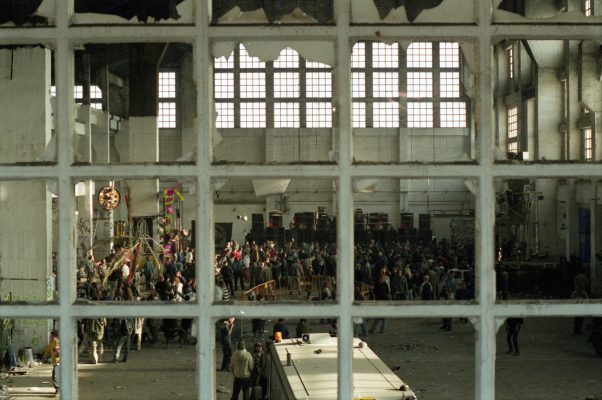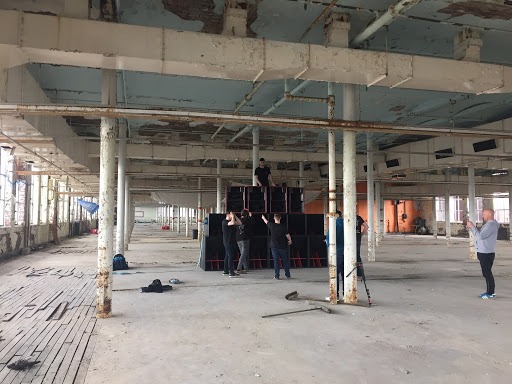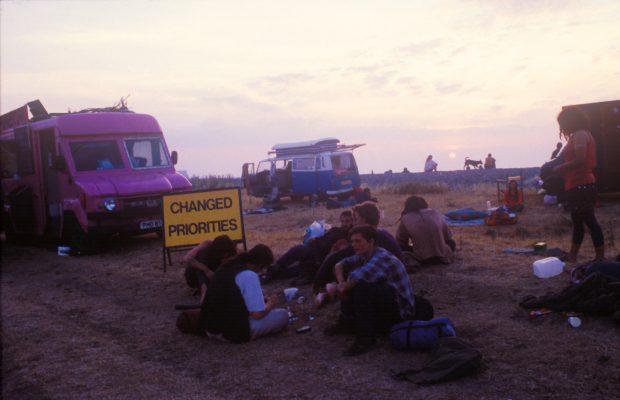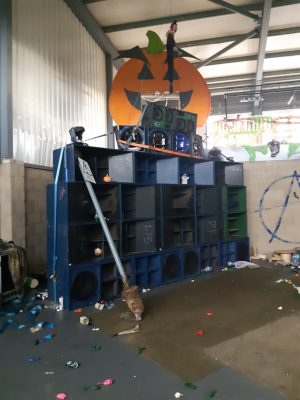Drum and Bass Culture, Introspective, Music History
Are Illegal Raves In The U.K. Making A Comeback?
Illegal raves in the U.K. are something of highway-man, Dick Turpin-esq folk tale spoken about by people in their 40’s who used to go to them when they were on. They are often referred to as ‘proper raves.’ Raves that used to go on all day and all night, put on somewhere in a field, quarry, abandoned warehouse or other out of the way venue. Organised by people who had sound systems and decks.

They weren’t about making money. They were about people being able to express themselves freely, without judgement wherever they wanted to.
Some of the very first people who drove the scene forwards were a group called Spiral Tribe. Mostly lost to the annals of history now, you can still find documentaries on YouTube about them. 23-minute warning is a good place to start. Incidentally, these people were friends of yours truly’s parents. I even have early mixtapes recorded from some of the events put on from way back in the 80’s.
Getting to one of those raves meant you had to be in with the crowd. Usually, you’d see a flyer put up somewhere with ‘party hotline’ written on it. It would be a number you could call that would give a vague description of where the rave would be and if you found it, good for you!
Initially, it was thought that the free parties and raves were a form of protest against a Tory government that was driving forwards with austerity. Wages were down, unemployment up and a lot of the youth were feeling very disenfranchised. With similarities of today and then, it’s no wonder that illegal raves in the U.K. are making a comeback.
What Is An Illegal Rave?
 Technically, illegal raves in the U.K. are anywhere that music “characterised by the emission of a succession of repetitive beats,’ according to the Criminal Justice and Public Order Act. 1994. So technically that party yo have with your mates on the weekend round your house is an illegal rave. Depending on how wild your party gets, it’s unlikely to get shut down by the police. You are further less likely to be arrested for it and have all of your equipment confiscated and destroyed.
Technically, illegal raves in the U.K. are anywhere that music “characterised by the emission of a succession of repetitive beats,’ according to the Criminal Justice and Public Order Act. 1994. So technically that party yo have with your mates on the weekend round your house is an illegal rave. Depending on how wild your party gets, it’s unlikely to get shut down by the police. You are further less likely to be arrested for it and have all of your equipment confiscated and destroyed.
What we are really talking about here are the large scale events put on in abandoned buildings around the country, quarries, fields and anywhere else people can smuggle a soundsystem. Back in the day (yes, I know I’m starting to sound like one of them) the raves we went to were pretty unsophisticated. Someone would have a table set up for the decks, which were vinyl only, a stack of speakers and a generator. If you had a small disco light that would be a bonus.
Nowadays, you are likely to find a whole array of light and sound set ups.
Regardless of the set up, illegal raves in the U.K. are simply that. An unlicensed venue somewhere out of the way where people are able to play music, socialise and enjoy themselves for little to no money.
Where Did Illegal Raves In The U.K. Stem From?
We love a bit of pop culture here at Amen Breaks. This article is no different. The early illegal raves in the U.K. started simply as free parties. The hippies liked to get together, take drugs and enjoy some music together. You couldn’t really call them raves at this point as they were simply small gathers where people enjoyed music and the mind-altering substances they ingested.
As with most things, money became involved which meant that the drugs were no longer being given out for free and of course there were people behind the supply of them.
Here is where things started to get more complex and the reasons behind why raves started happening up and down the country began.
Britain at the time was in the midst of a Tory death grip. Housing was unaffordable, wages were down, unemployment up, inflation, poll tax riots and a war in the Middle East. Young people especially were feeling let down, angry and wanted to take back a modicum of control in their daily lives. One way in which to do so was to simply have a party.

Add the sudden influx of Acid house from America, the huge availability of illegal substances, such as ecstasy and the massive potential of profit, the free party scene quickly morphed into something a bit more unwieldy. Naturally, the police and government didn’t want what it considered large amounts of people gathering in what could turn into a riot.
The rave scene, it could be argued, eventually turned into a form of protest. The infamous 1994 London Protest Rave is a prime example of how young people were staking their claim that they were not criminals. They just wanted to be able to have a good time without fear of being arrested for it.
This wasn’t the only protest rave; they were held across the country with the same objective. Fight the ban against the raves. The free party scene had mobilised itself into a political movement. However, with no real leadership or structure, the protests often descended into anarchy and often turned violent, fueling the belief that the Criminal Justice Act was the right legislative measure.
The legendary Castlemorton free party in 1992 was the tipping point for the authorities. A huge week-long gathering, resembling a modern day festival, took place near Malvern. Police couldn’t shut it down as over 30,000 people turned up. It sparked outrage from politicians which lead to the development of the bill.
Where and Why Are Illegal Raves In The U.K. Making A Comeback?

Illegal raves in the U.K. are popping up in the same places they were when they first started. Warehouse, abandoned buildings, fields, quarries, forests; wherever there is a space to host a soundsystem and ravers.
Naturally the cities tend to have a larger volume of illegal raves due to proximity and population density. It simply makes sense that so many people would want to take advantage of the spaces available. In recent times, with police numbers slashed, the opportunity and ability to not only put on, but be completely unhindered by the police means illegal event organisers are becoming bolder.
In a recent Vice documentary about the Illegal rave scene, it is quite apparent that every city up and down the country is hosting illegal raves. It’s not just in the city either. In rural areas raves are being set up, which in turn draw in people from the cities.
So why are illegal raves in the U.K. becoming so popular again? Unlike in the ‘90’s, there isn’t a politically motivated agenda. Young people aren’t having illegal raves or free parties to defend a way of life or send a message to the government. These raves are being put on as an alternative night to what is currently on offer in town.
There is an element of similarity between the two time periods. Times are hard for young British people. Brexit and uncertainty about the future economy all play on people’s minds. On an immediate note, the public health crisis with COVID-19 is worrying people. Going to a club or confined space where transmission of the virus may happen is a scary thought.
As stated above, there are also less police around and people will always be opportunistic. The threat of being caught is considerably lower, which means people are more likely to take the risk. Ravers are always looking for a new experience and those that have never gone to an illegal rave find the idea of going to a hidden venue for a night of hedonism particularly enticing.
There is also a train of thought amongst ravers that nights out in town have become sterile. Clubs dominate the dance music scene, often catering to the lowest common denominator. Those that don’t e.g. Fabric, Ministry Of Sound etc… charge high entry fees, expensive drinks and there’s always talk of the bouncers being ‘overly proactive’ in the duties and responsibilities. A free party, by very definition, is free. Meaning that you don’t pay anything to get in. You take what you want to consume with you, whatever that may be, and enjoy the rave at your own pace. Illegal raves in the U.K. offer a low-cost alternative to the traditional night out in town. They offer a different vibe and experience.
Are Illegal Raves In The U.K. Any Good?
That depends. A lot of the time the raves are dj’ed by amateurs doing it for free. So you are unlikely to be getting the same production value as that of a Rampage set. In fact, many of the people we’ve spoken to would say the djing is actually of pretty low quality but they really don’t care.
It can also be pot luck as to whether or not the music being played is a genre you like, but this is being overshadowed by the fact you are able to be at a different scene altogether. Ultimately, it’s a burgeoning scene being run by amateurs, much like it was in the early days. Many people remember those raves as probably better than they were, but it was definitely the experience that made them as great as they are fondly remembered.
A New Era Of Illegal Raves
 There is a stark contrast in the new scene of illegal raves in the U.K. that those of the original free parties. In the late 80’s and early 90’s, the free parties were just that. People getting together to enjoy music and the scene they were growing. It was a group of enthusiasts who were so passionate about the music and community they were making that the scene itself became an infectious beacon for lost souls looking to find their own people.
There is a stark contrast in the new scene of illegal raves in the U.K. that those of the original free parties. In the late 80’s and early 90’s, the free parties were just that. People getting together to enjoy music and the scene they were growing. It was a group of enthusiasts who were so passionate about the music and community they were making that the scene itself became an infectious beacon for lost souls looking to find their own people.
The new scene of illegal raves in the U.K. is built on very different objectives. Some of the free parties you can attend aren’t actually free. There will be a cover charge to get in. Even though it will be significantly cheaper than club entry, it still is absolutely against the initial concept of free parties.
The organisers of these events may also not be that interested in the music or people turning up. Free party event organisers are trying to build reputations that will enable them to leverage their position on the street. We have heard tale of raves being put on yet been massively disappointing because of the poor sound system, djing and experience. The organiser was simply trying to get as many people in the one place as they could to show they could pull in numbers.
The people who go to these illegal raves in the U.K. are also unlikely to be passionate followers of the music played. They are simply looking for a cheap night out away from the mainstream social entertainment.
Does this mean that free parties aren’t as good as the ones years ago? No. Plenty of them were pretty awful too. They are simply a different construct to what they used to be. Illegal raves today have their place within the scene and provide a space for experimentation and boundary pushing, much like the original raves did.
To that end, are illegal raves in the U.K. making a comeback? Well, they never really went away. People were just satisfied with the change in clubbing scene and were happy that they were allowed to go to legal raves, paving the way for events like the legendary Fantazia at Donnington Park in 1992, leading all the way up to modern events like Rampage, Hospitality and Let It Roll.
One thing’s for sure, they aren’t going away!

